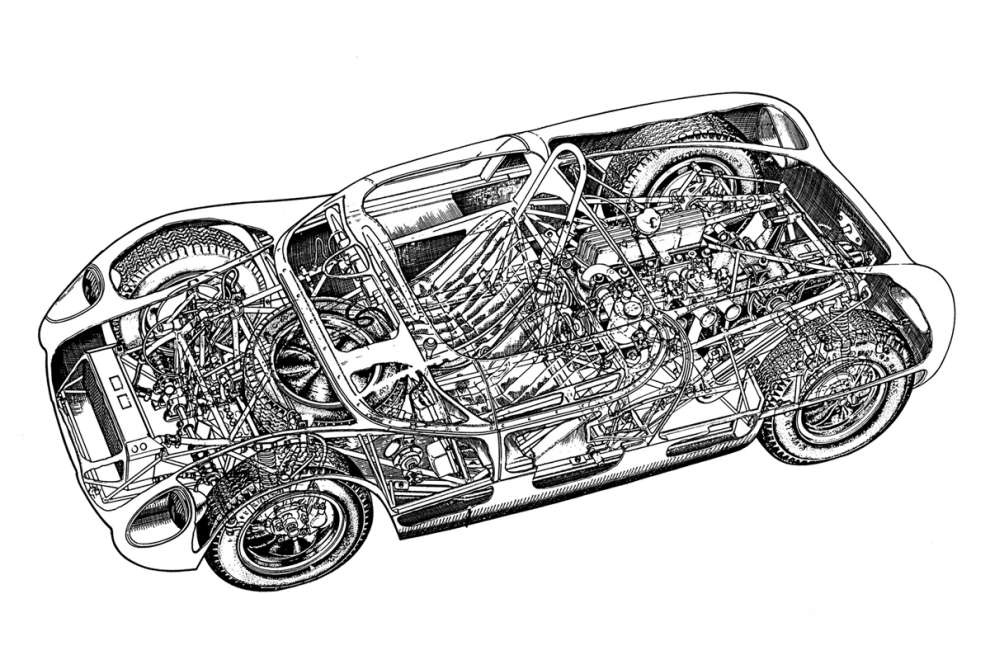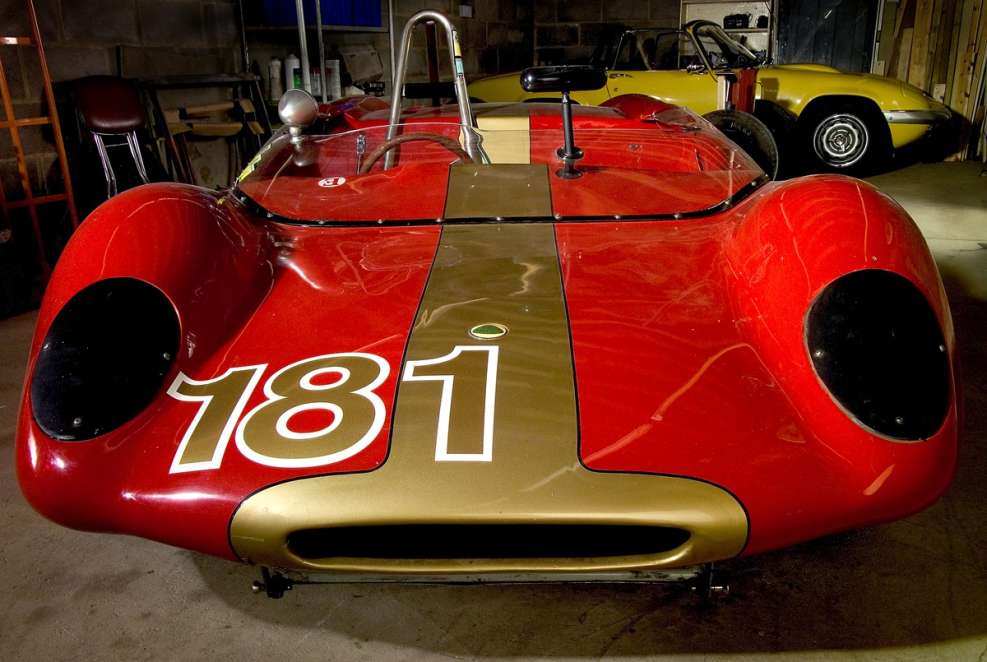Lotus, the Ferrari of England
There Lotus it has often been defined as “the Ferrari of England” and this not only because the English Formula 1 team was one of the most successful in the 60s and 70s, but also for its economic model. Just like Ferrari, Lotus also designed and built road racing cars which were then sold to private drivers with the aim of financing the sporting activity of the English company. It was certainly the most prestigious showcase for a sports car manufacturer wanting to promote its high performance cars the 24 Hours of Le Mans. Lotus had participated in the Sarthe race several times, achieving class victories with its cars Elite and Eleven above all, racing with particularly agile and light GT cars, powered by compact engines with a displacement of less than two litres.
The little devil
In 1962 Colin Chapman, founder of Lotus and brilliant designer of the English cars that represented real milestones in the technical history of motorsport, decided to produce a new model of GT car to compete in the category races of that season, with the aim of returning to race at Le Mans to promote it as best as possible. It was about the Lotus 23, a car with particularly elegant shapes, weighing just 440 kilograms and designed to accommodate lightweight small displacement engines, from 750 to 1500cc, obviously mounted in a rear position. Its lightness was also due to the classic construction with a tube trellis frame and fiberglass bodywork. The front and rear suspensions were double wishbones. After a debut at the 12h of Sebring without seeing the checkered flag, the “23” ran several races in early 1962 entrusted to private teams and drivers, but collected a long series of retirements and few placings. Finally came the first victory at Cadwell Park, in a minor race, on 20 May to the delight of his private driver Rodney Bloor. A victory that pushed Chapman to field an example of the Lotus 23 at the 1000 km of the Nurburgring of the following May 27th entrusting it to none other than Jim Clark and Trevor Taylor, former drivers of the Lotus F1 team loaned to the Essex Racing team. The 1000 km of the Nurburgring was the ideal test bed for the now approaching 24 hours of Le Mans and the German track was still in the configuration which provided for a development of 22.8 km. Racing cars like the ones entered in that race Ferrari 330 GTO, Porsche 718 and Aston Martin DBR1. All cars equipped with V6, V8 and V12 engines of displacement and power well superior to that of the small Lotus 23 which appeared at the Nurburgring powered by a Lotus-tuned Ford 1500cc engine with a power of just 103 horsepower.

With Clark the twenty-third flies
At the start of the race the track was very damp after one of the typical rains that could wet the German track. Against all odds, given the field of opposing cars, it was Clark who took the lead from the start, closing the first lap of the very long German circuit with a gap of 27 seconds on Gurney's Porsche 718 which grew to 47 seconds per second. round and well 1 minute and 13 seconds in third, also setting the fastest lap. Unfortunately for Clark and Chapman, and in full Lotus tradition due probably to the extreme construction of the materials in every part of the car, the engine's exhaust manifold began to loosen, venting the fumes towards the driver who began to feel a certain dizziness. The car's brakes also began to have some problems and the combination of these two effects meant that Clark went off the track at the Kesselchen cure and ended his race in the bushes on the side of the track. Curiously, at a point on the German track just after Niki Lauda's famous accident in 1976. Despite the inglorious ending of that race the Lotus 23, thanks to Clark's phenomenal performance, had attracted the worried attention of all its most famous rivalsalso in light of the fact that after just one month they would all find themselves racing in the 24 Hours of Le Mans.
24 hours of controversy
For the Sarthe race, Chapman applied important modifications to the Lotus 23. He installed a Ford-derived twin-camshaft engine of just 1000 cm3 on the car, which should have allowed him to have an excellent chance of winning in his category. Furthermore, he increased the size of the windshield to comply with the technical regulations of the race which included a series of very particular specifications, so much so that the technical checks on Tuesday were a very delicate moment for everyone. The ACO commissioners, after checking the two examples of Lotus 23 entered in the race, declared the car not compliant with the technical regulations disqualifying her from the event without admitting her to the qualifying tests. The irregularities complained of were various: too large fuel tanks, insufficient turning circle and ground clearance. Really the wheel fixing system was contested which consisted of six bolts at the rear and four at the front. The latter is a question of real goat's wool because the regulation simply defined that the method of fixing the wheels on the two axles had to be the same. Technically it was because the same bolts were used to secure the wheel to the hub but the commissioners contested the different number of the same between the wheels of the two axles. The pedantry of these remarks began to make Chapman suspect that they were the result of political pressure from his opponents to avoid racing his already fearsome Lotus 23. Nonetheless, Colin, who had remained in England in those hours, asked his man in the field Mike Costin (future father of the legendary Cosworth engine) to make every effort to modify the car according to the reports of the commissioners. The latter, however, once again proved to be anything but benevolent by conceding to Costin just one day to modify the car and allow it to take part in Thursday's qualifying. They probably thought that with so few hours available no one would be able to modify the car according to all those indications. They had not taken into account the obstinacy and genius of Chapman and his technicians who designed and produced all the necessary parts in a few hours and sent the components by air to Le Mans where the mechanics with feverish work managed to modify the car and present it to the commissioners for the new technical checks. To Costin's enormous dismay, however, the ACO commissioners confirmed the disqualification of Lotus 23 for technical irregularities. This is because, despite having applied all the required corrections, the number of wheel fixing bolts on the two axles was now the same, but as these were in number four per wheel also to the rear axle (instead of six originals) the commissioners contested the fact that the safety of the car had been reduced compared to the original design.
The historic divorce
Costin's vigorous protests were of no use and he made himself available to demonstrate, with calculations in hand, that the car was more than safe and that the six bolts at the rear represented a conservative solution by virtue of the fact that the Lotus 23 was designed to be able to accommodate also much more powerful engines than the 1000 cm3 installed at Le Mans. The confirmation of the disqualification, for these reasons, then infuriated Chapman who drove his private plane to Le Mans taking with him the secretary of the Royal Automobile Club to protest in the strongest politically possible way. Tension was running high on the eve of that race and the news of Lotus' disqualification had already gone around the world among the trade press and the public. The result of Chapman's pressure was very modest since all he obtained was the return of the participation deposit for the race. This escalation of extremely specious technical observations by the ACO commissioners had the obvious result of maximum attention towards any irregularities on the part of all competitors towards their opponents. The day of the race the Ferrari Dino 246 of the Rodriguez brothers, regular at the checks in the previous days, was verified with insufficient ground clearance and Lotus officially complained to the ACO. A venial sin was that of the height from the ground which everyone usually indulged in but in that situation the tolerance was now zero. It was a big problem because Ferrari and the Rodriguez brothers were names with great appeal to the race public. It was for this reason that the Ferrari team manager on the field, Eugenio Dragoni, responded to the organizers' verbal request to quickly fix the Rodriguez's car with a threatening “You have five seconds to say that the car is legal otherwise we will withdraw the entire Ferrari team from the race”.
A serious threat for the ACO which without Ferrari would have had a “24 hours” mutilated in its interest and this was why Rodriguez's car was admitted to the race anyway which was won by GendebienHill in a Ferrari 330. To complete the podium two Ferrari 250 GTOs. The Lotus Elite won the GT1.3 class of HobbsGardner, eighth overall at the finish line and fielded by the official Lotus Engineering team. A success which in no way alleviated Colin Chapman's disappointment and anger at the disqualification of his car which he declared, keeping true to his word, that from that day on Lotus would no longer race at Le Mans.

It was a historic divorce between Lotus and Le Mans which, considering the development of the English team in the 60s and 70s with the conquest of nine F1 world titles (the first already in 1963 with Clark) deprived the history of motorsport of important pages. Lotus would have been a formidable opponent for Ferrari and especially Porsche which perhaps would have given it a run for its money at the 24 hours of Le Mans, where the German company achieved a formidable series of successes. However, the Lotus 23 had a truly long career, like many of Chapman's cars, racing in numerous competitions until 1974 in the hands of private drivers and teams, making its last appearance in 1981 almost twenty years after its debut. Even today there are several examples or replicas of the Lotus 23 that compete on tracks around the world to the delight of those lucky enough to enjoy its exceptional driving characteristics in terms of handling and agility.
#fast #race #big #boys #FormulaPassion.it

